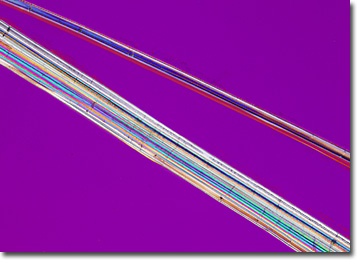Polarized Light Microscopy Digital Image Gallery
Flax Fibers
Flax is the common name of plants in the family Linaceae, which have been cultivated for thousands of years for their fiber, also termed flax. An herbaceous annual, signs of its use have even been discovered in Switzerland in abodes inhabited by prehistoric man.

Flax plants that yield the best fiber are grown in moist, cool conditions in high densities so that the woody stems become tall and slender, rather than short and branching. When harvested, the fiber of the plants is obtained through a series of processes that begins with deseeding and is followed by retting, which involves soaking the flax in water for several days in order to soften and separate the fibers through partial rotting. The fibers are then dried and scutched, or beaten, before they are hackled, or combed, to separate the short, coarse flax (called tow) from the long, fine flax. The long flax fibers are typically spun into thread and woven into fine linen, while the short-fibered tow is often utilized as coarse yarn, cordage, and padding in upholstery.
Linen made from high quality flax fibers is a remarkable material, which has been appreciated by many civilizations throughout history, including the ancient Egyptians who used it, among other things, to wrap mummies. Beautiful to behold due to its smoothness and lustrous sheen, the popular textile is also highly practical because it is absorbent, strong, durable, and resistant to microbial activity. Linen possesses exceptional heat conducting capabilities as well, which helps keep people who wear it as clothing cool during warm summers. The material is, however, subject to frequent wrinkling and cannot be readily dyed, though it may be bleached.
